体验SpringCloud Gateway
Spring Cloud Gateway是Spring Cloud技术栈中的网关服务,本文实战构建一个SpringCloud环境,并开发一个SpringCloud Gateway应用,快速体验网关服务;
环境信息
- 操作系统:win10(64位)
- JDK:1.8.0_181
- Maven:3.5.0
- Spring Cloud:Greenwich.SR
源码下载
如果您不打算写代码,也可以从GitHub上下载本次实战的源码,地址和链接信息如下表所示:
| 名称 | 链接 | 备注 |
|---|---|---|
| 项目主页 | https://github.com/zq2599/blog_demos | 该项目在GitHub上的主页 |
| git仓库地址(https) | https://github.com/zq2599/blog_demos.git | 该项目源码的仓库地址,https协议 |
| git仓库地址(ssh) | git@github.com:zq2599/blog_demos.git | 该项目源码的仓库地址,ssh协议 |
这个git项目中有多个文件夹,本章的源码在gatewaydemo文件夹下,如下图红框所示:

整体设计
本次实战的源码涉及到三个应用:注册中心、服务提供者、网关,它们的关系和业务逻辑如下图:

整个工程基于maven构建,采用父子结构,父工程名为gatewaydemo,里面有三个modular,分别是:eureka()注册中心)、provider(服务提供者)、网关(gateway),在IDEA上呈现的结构如下图所示:
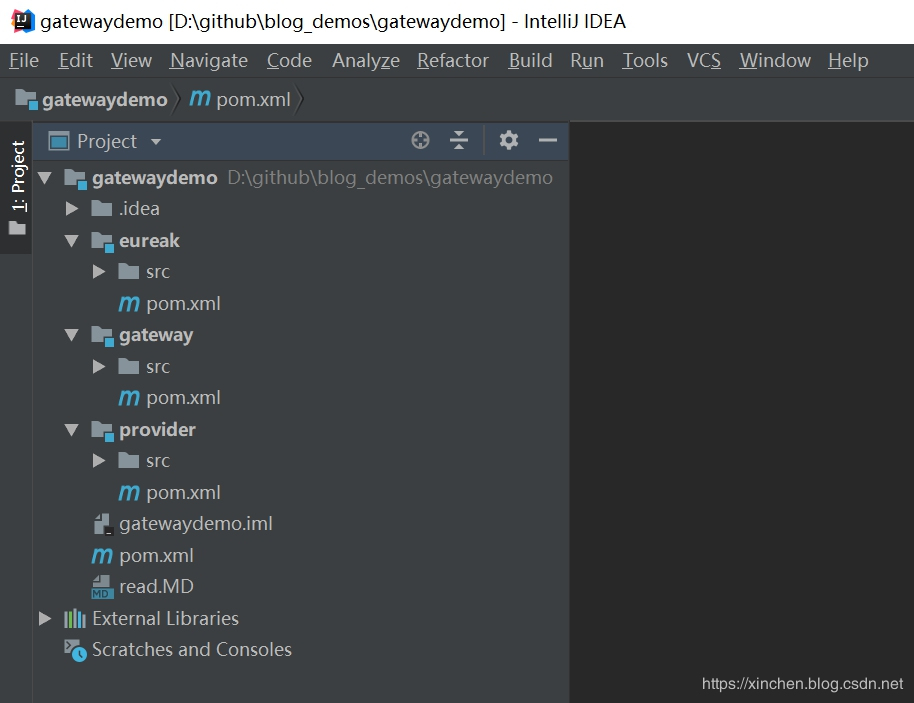
准备完毕,开始编码吧;
创建父工程
- 创建名为gatewaydemo的maven工程,pom.xml内容如下,这是个典型的父子工程pom,dependencyManagement节点接管了版本匹配:
<?xml version="1.0" encoding="UTF-8"?>
<project xmlns="http://maven.apache.org/POM/4.0.0"
xmlns:xsi="http://www.w3.org/2001/XMLSchema-instance"
xsi:schemaLocation="http://maven.apache.org/POM/4.0.0 http://maven.apache.org/xsd/maven-4.0.0.xsd">
<modelVersion>4.0.0</modelVersion>
<parent>
<groupId>org.springframework.boot</groupId>
<artifactId>spring-boot-starter-parent</artifactId>
<version>2.1.6.RELEASE</version>
<relativePath/>
</parent>
<groupId>com.bolingcavalry</groupId>
<artifactId>gatewaydemo</artifactId>
<packaging>pom</packaging>
<version>1.0-SNAPSHOT</version>
<modules>
<module>eureak</module>
<module>provider</module>
<module>gateway</module>
</modules>
<properties>
<java.version>1.8</java.version>
<spring-boot.version>2.1.6.RELEASE</spring-boot.version>
<maven-compiler-plugin.version>3.5</maven-compiler-plugin.version>
<maven-deploy-plugin.version>2.8.2</maven-deploy-plugin.version>
<maven-failsafe-plugin.version>2.18.1</maven-failsafe-plugin.version>
<maven-surefire-plugin.version>2.21.0</maven-surefire-plugin.version>
<spring-cloud.version>Greenwich.SR2</spring-cloud.version>
</properties>
<dependencyManagement>
<dependencies>
<dependency>
<groupId>org.springframework.cloud</groupId>
<artifactId>spring-cloud-dependencies</artifactId>
<version>${spring-cloud.version}</version>
<type>pom</type>
<scope>import</scope>
</dependency>
</dependencies>
</dependencyManagement>
</project>
- 如果您是用IDEA创建的工程,那么IDEA可能会在pom.xml所在目录自动创建src文件夹,请手动将其删除,因为用不上;
eureka工程
- 接下来是创建注册中心,鼠标右键点击gatewaydemo文件夹,选择"New -> Module":
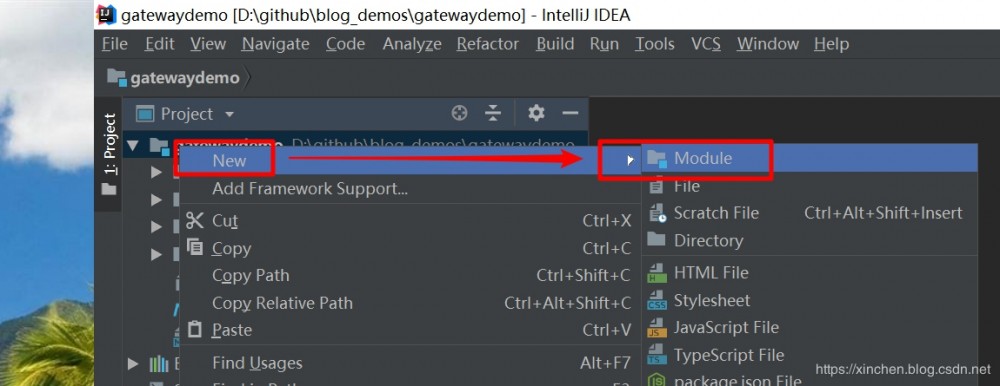
- 在弹出窗口选择Spring Initializr,如下图:
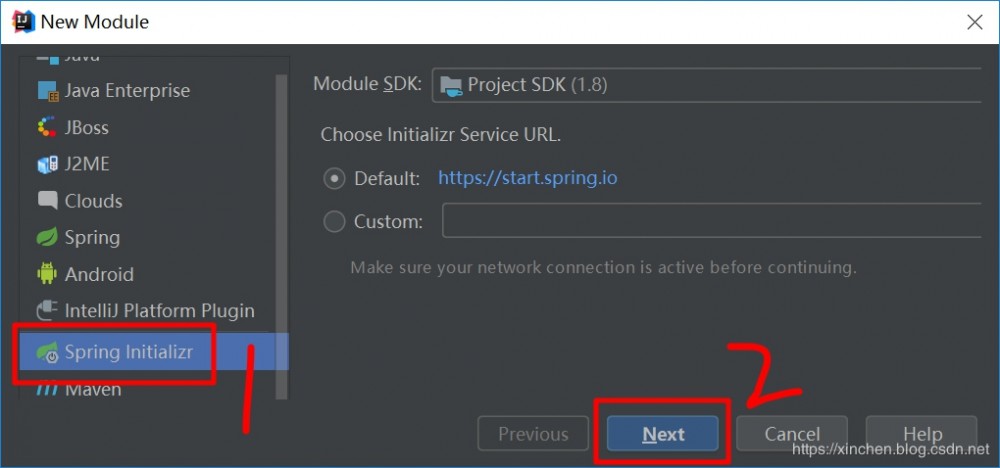
- 接下来的窗口填写Group、Artifact(这里是eureka)、Version等信息,其余的默认,即可完成子工程的创建;
- 新的eureka模块的pom.xml,请修改成如下内容,可见除了指定父工程,还依赖了spring-cloud-starter-netflix-eureka-server:
<?xml version="1.0" encoding="UTF-8"?>
<project xmlns="http://maven.apache.org/POM/4.0.0" xmlns:xsi="http://www.w3.org/2001/XMLSchema-instance"
xsi:schemaLocation="http://maven.apache.org/POM/4.0.0 http://maven.apache.org/xsd/maven-4.0.0.xsd">
<parent>
<artifactId>gatewaydemo</artifactId>
<groupId>com.bolingcavalry</groupId>
<version>1.0-SNAPSHOT</version>
</parent>
<modelVersion>4.0.0</modelVersion>
<artifactId>eureak</artifactId>
<packaging>war</packaging>
<name>eureak Maven Webapp</name>
<dependencies>
<dependency>
<groupId>org.springframework.cloud</groupId>
<artifactId>spring-cloud-starter-netflix-eureka-server</artifactId>
</dependency>
</dependencies>
<build>
<finalName>${project.artifactId}</finalName>
<plugins>
<plugin>
<groupId>org.springframework.boot</groupId>
<artifactId>spring-boot-maven-plugin</artifactId>
</plugin>
</plugins>
</build>
</project>
- src/main/resources目录下新增application.yml文件,内容如下,这是普通的注册中心设置:
spring:
application:
name: eureka
server:
port: 8080
eureka:
client:
service-url:
defaultZone: http://localhost:${server.port}/eureka/
fetch-registry: false
register-with-eureka: false
- java文件只有一个,就是启动类,还通过注解EnableEurekaServer开启了注册中心服务:
package com.bolingcavalry.eureka;
import org.springframework.boot.SpringApplication;
import org.springframework.boot.autoconfigure.SpringBootApplication;
import org.springframework.cloud.netflix.eureka.server.EnableEurekaServer;
@SpringBootApplication
@EnableEurekaServer
public class EurekaApplication {
public static void main(String[] args) {
SpringApplication.run(EurekaApplication.class, args);
}
}
-
以上就是注册中心eureka的内容,运行EurekaApplication即可启动服务,访问8080端口的结果如下:
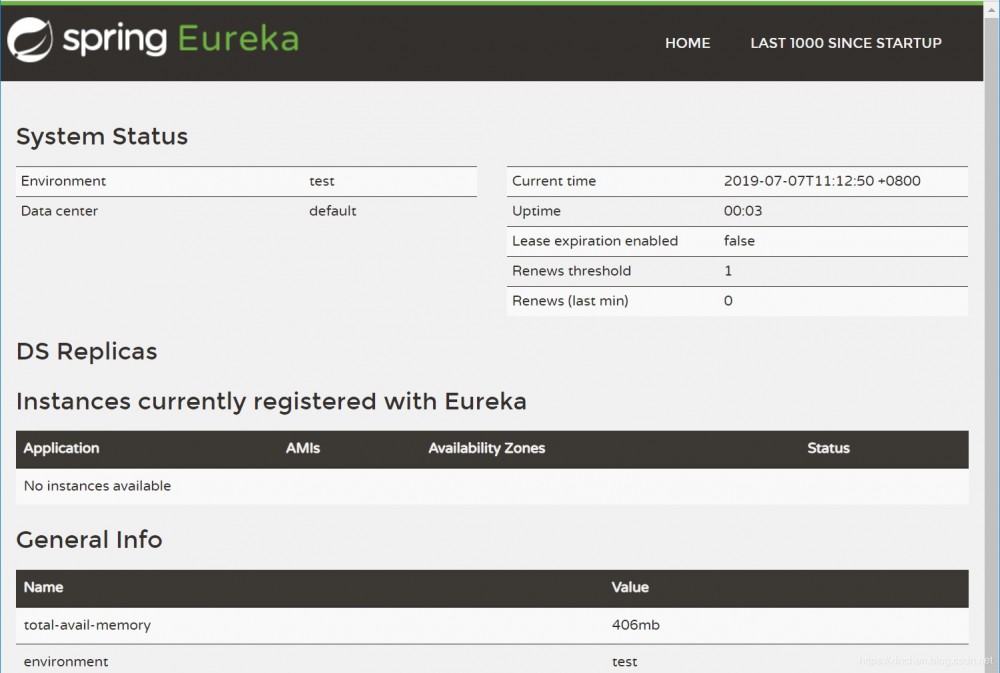
现在注册中心已经就绪,开始编写服务提供者provider应用的代码吧。
provider工程
- 在gatewaydemo下创建一个子工程,名为provider,pom.xml内容如下,可见用到了spring-boot-starter-web和spring-cloud-starter-netflix-eureka-client这两个依赖,分别用来支持web服务和注册发现:
<?xml version="1.0" encoding="UTF-8"?>
<project xmlns="http://maven.apache.org/POM/4.0.0"
xmlns:xsi="http://www.w3.org/2001/XMLSchema-instance"
xsi:schemaLocation="http://maven.apache.org/POM/4.0.0 http://maven.apache.org/xsd/maven-4.0.0.xsd">
<parent>
<artifactId>gatewaydemo</artifactId>
<groupId>com.bolingcavalry</groupId>
<version>1.0-SNAPSHOT</version>
</parent>
<modelVersion>4.0.0</modelVersion>
<artifactId>provider</artifactId>
<dependencies>
<dependency>
<groupId>org.springframework.boot</groupId>
<artifactId>spring-boot-starter-web</artifactId>
</dependency>
<dependency>
<groupId>org.springframework.cloud</groupId>
<artifactId>spring-cloud-starter-netflix-eureka-client</artifactId>
</dependency>
</dependencies>
<build>
<finalName>${project.artifactId}</finalName>
<plugins>
<plugin>
<groupId>org.springframework.boot</groupId>
<artifactId>spring-boot-maven-plugin</artifactId>
</plugin>
</plugins>
</build>
</project>
- 配置文件application.yml如下,指定了注册中心地址,并且自身端口为8081:
eureka:
client:
serviceUrl:
defaultZone: http://localhost:8080/eureka/
server:
port: 8081
spring:
application:
name: provider
- 启动类ProviderApplication.java:
package com.bolingcavalry.provider;
import org.springframework.boot.SpringApplication;
import org.springframework.boot.autoconfigure.SpringBootApplication;
@SpringBootApplication
public class ProviderApplication {
public static void main(String[] args) {
SpringApplication.run(ProviderApplication.class, args);
}
}
- 增加一个controller,用于响应web请求,注意hello方法会从请求的header中取出名为extendtag的属性值,返回给浏览器:
package com.bolingcavalry.provider.controller;
import org.springframework.web.bind.annotation.RequestMapping;
import org.springframework.web.bind.annotation.RequestMethod;
import org.springframework.web.bind.annotation.RestController;
import javax.servlet.http.HttpServletRequest;
import java.text.SimpleDateFormat;
import java.util.Date;
@RestController
@RequestMapping("/hello")
public class HelloController {
@RequestMapping(value = "time", method = RequestMethod.GET)
public String hello(HttpServletRequest request){
return "hello, "
+ new SimpleDateFormat("yyyy-MM-dd HH:mm:ss").format(new Date())
+ ", extendtag ["
+ request.getHeader("extendtag")
+ "]";
}
}
- 启动应用,再次刷新eureka的页面localhost:8080,可见provider应用已经注册上去了,如下图红框所示:
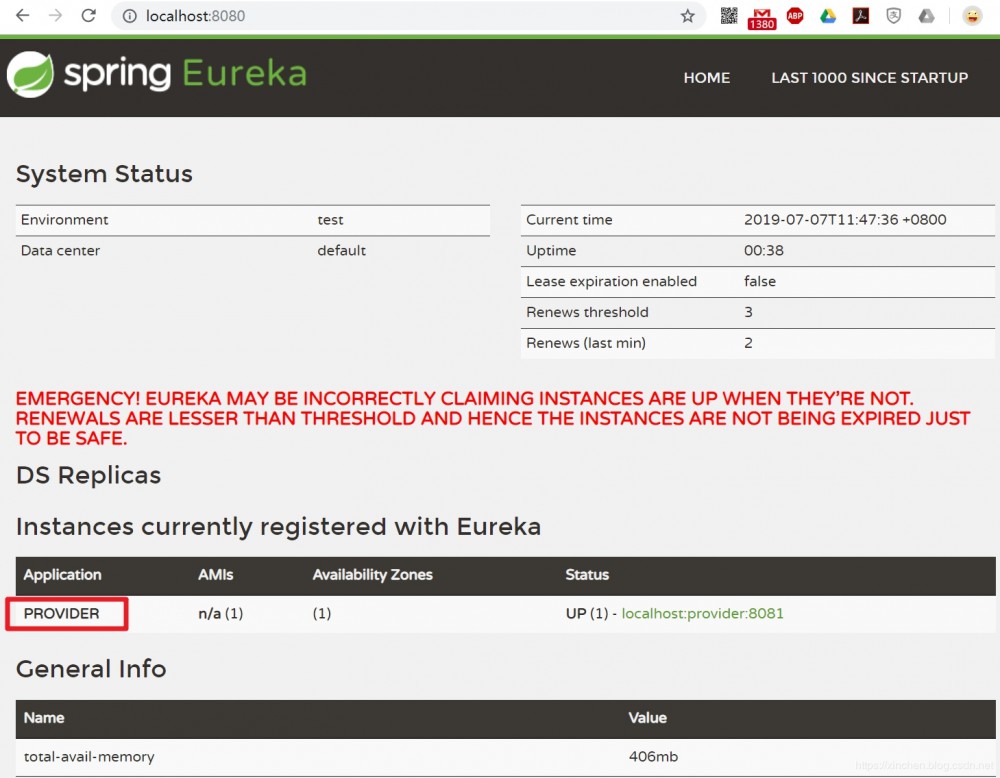
- 访问地址:http://localhost:8081/hello/time ,这是controller提供的web服务接口,得到响应如下图,因为header中没有名为"extendtag"的属性,因此返回了null:
 提供服务的provider已经OK,可以开发网关服务了;
提供服务的provider已经OK,可以开发网关服务了;
gateway工程
- 在gatewaydemo下创建一个子工程,名为gateway,pom.xml内容如下,可见用到了spring-cloud-starter-gateway和spring-cloud-starter-netflix-eureka-client这两个依赖,分别用来支持网关服务和注册发现:
<?xml version="1.0" encoding="UTF-8"?>
<project xmlns="http://maven.apache.org/POM/4.0.0"
xmlns:xsi="http://www.w3.org/2001/XMLSchema-instance"
xsi:schemaLocation="http://maven.apache.org/POM/4.0.0 http://maven.apache.org/xsd/maven-4.0.0.xsd">
<parent>
<artifactId>gatewaydemo</artifactId>
<groupId>com.bolingcavalry</groupId>
<version>1.0-SNAPSHOT</version>
</parent>
<modelVersion>4.0.0</modelVersion>
<artifactId>gateway</artifactId>
<dependencies>
<dependency>
<groupId>org.springframework.cloud</groupId>
<artifactId>spring-cloud-starter-netflix-eureka-client</artifactId>
</dependency>
<dependency>
<groupId>org.springframework.cloud</groupId>
<artifactId>spring-cloud-starter-gateway</artifactId>
</dependency>
</dependencies>
<build>
<finalName>${project.artifactId}</finalName>
<plugins>
<plugin>
<groupId>org.springframework.boot</groupId>
<artifactId>spring-boot-maven-plugin</artifactId>
</plugin>
</plugins>
</build>
</project>
- 配置文件application.yml如下,指定了注册中心地址,并且自身端口为8082,还有开启了网关服务:
server:
port: 8082
spring:
application:
name: gateway
cloud:
gateway:
discovery:
locator:
enabled: true
lowerCaseServiceId: true
eureka:
client:
service-url:
defaultZone: http://localhost:8080/eureka/
- 启动类GatewayApplication .java,可见实例化了一个RouteLocator,该实例就是路由规则,具体的功能请参考代码中的注释:
package com.bolingcavalry.gateway;
import org.springframework.boot.SpringApplication;
import org.springframework.boot.autoconfigure.SpringBootApplication;
import org.springframework.cloud.gateway.route.RouteLocator;
import org.springframework.cloud.gateway.route.builder.RouteLocatorBuilder;
import org.springframework.context.annotation.Bean;
@SpringBootApplication
public class GatewayApplication {
public static void main(String[] args) {
SpringApplication.run(GatewayApplication.class, args);
}
@Bean
public RouteLocator customRouteLocator(RouteLocatorBuilder builder) {
return builder.routes()
//增加一个path匹配,以"/gateway/hello/"开头的请求都在此路由
.route(r -> r.path("/customize/hello/**")
//表示将路径中的第一级参数删除,用剩下的路径与provider的路径做拼接,
//这里就是"lb://provider/hello/",能匹配到provider的HelloController的路径
.filters(f -> f.stripPrefix(1)
//在请求的header中添加一个key&value
.addRequestHeader("extendtag", "geteway-" + System.currentTimeMillis()))
//指定匹配服务provider,lb是load balance的意思
.uri("lb://provider")
).build();
}
}
- 启动应用,再次刷新eureka的页面localhost:8080,可见gateway应用已经注册上去了,如下图红框所示:
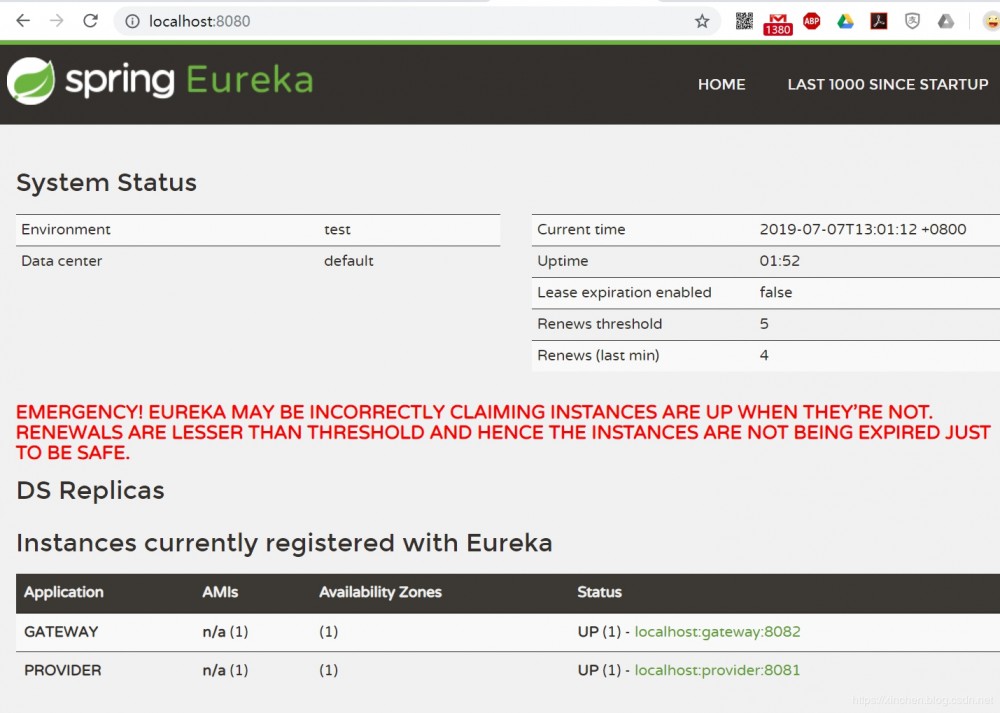
-
访问地址:http://localhost:8082/customize/hello/time ,这是符合前面我们配置的路由规则的路径,customize被删除掉之后,将剩余的路径转发到provider服务,于是请求的真正地址就是provider服务的/hello/time,得到响应如下图,因为gateway在转发的时候给header中设置了名为"extendtag"的属性,因此返回了extendtag是有内容的:

至此,极速体验SpringCloud Gateway的实战就完成了,这里我们只简单的体验了Gateway的一些基本功能,希望本文能帮助您快速搭建环境和开发应用,其实该框架的功能是非常强大的,如果您有兴趣建议从官网的API文档入手深入学习。
欢迎关注我的公众号:程序员欣宸

- 本文标签: client UI plugin tag 实例 源码 开发 https 下载 springboot 代码 java Eureka pom build 配置 ORM 注册中心 HTML 协议 操作系统 git 删除 GitHub id spring value maven schema map bean Netflix 程序员 web dependencies ip http API 希望 目录 key 端口 provider cat Service Spring cloud App apache 参数 servlet src IDE IO XML tab final tar maven构建 springcloud 注释 ssh REST
- 版权声明: 本文为互联网转载文章,出处已在文章中说明(部分除外)。如果侵权,请联系本站长删除,谢谢。
- 本文海报: 生成海报一 生成海报二










![[HBLOG]公众号](https://www.liuhaihua.cn/img/qrcode_gzh.jpg)

